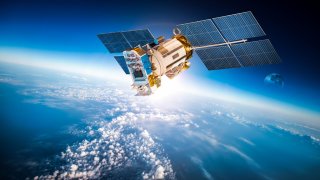China’s Space Strategy Dwarfs U.S. Ambitions
Beijing is already planning to send its first manned mission to the Moon in 2030, followed by the construction of a permanent base there by 2036.
Last month, rumors that Russia has been developing a space-based nuclear weapon took the media by storm. The technology in question, ominously dubbed a “serious national security threat” by House Intelligence Committee Chairman Mike Turner, left many in Washington asking how the United States itself is planning to capitalize on the strategic significance of outer space.
Russia, however, isn’t the most assertive actor in the space domain. That honor belongs to the People’s Republic of China (PRC), which has a clear plan to dominate outer space—and which is moving ahead with the full backing of the powers that be in Beijing.
China’s outer space strategy involves many things, from asteroid mining to increasing the number of PRC-fielded satellites to developing a rival to the U.S. GPS navigation system. However, its ultimate objective is clear: to bolster the country’s comprehensive national power. As the PRC itself has asserted, “To explore the vast cosmos, develop the space industry, and build China into a space power is our eternal dream.”
Consequently, China’s space program has made massive strides in recent years. The PRC’s Tiangong space station, for instance, initially entered Earth’s orbit in April 2021 and has since hosted six separate astronaut crews. Last year, Zhang Qiao, a researcher from the China Academy of Space Technology, announced that the station will double in size in the future to support the over 100 scientific research projects that have or are currently taking place in orbit. In addition, China successfully collected Lunar material in 2020 with its Chang’e-5 mission, landed its Zhurong rover on Mars in 2022, and completed a record sixty-seven targeted launches in 2023.
Most recently, researchers from the Harbin Institute of Technology (HIT) in northeast China unveiled plans for a manned facility on the Moon. Newly translated video footage from the Third Annual Space Science Conference in October 2023, co-hosted by the Chinese Society of Space Research and Zhejiang Province Science and Technology Association, presents a plan for an expansive Lunar installation. The base features subterranean living quarters, research labs, a greenhouse, a fleet of unmanned vehicles, a photovoltaic system, closed-cycle life support, and more. The purported purpose of the project, led by Chief HIT Engineer Mei Hongyuan, is to study the chemical composition of the Lunar surface.
The proposal in the video draws heavily on research from a 2022 paper published in the Chinese Journal of Deep Space Exploration titled “Research on Building Plans Design for Future China Lunar Base.” The report features several different design possibilities for a Chinese Lunar facility and emphasizes the fact that “the Moon is the Earth’s only natural satellite,” and that “countries must establish Lunar bases in order to take advantage of the Moon’s natural resources.”
Why should U.S. policymakers care about Chinese plans to build a base on the Moon? First, the plan has a considerable chance of becoming a reality. As many already know, China is no stranger to grand architectural undertakings (The Great Wall, the Grand Canal, Three Gorges Dam, etc.) and is already planning to send its first manned mission to the Moon in 2030, followed by the construction of a permanent base there by 2036.
Meanwhile, the credentials of the architect of China’s new Lunar Base plan suggest seriousness. Mr. Mei is a member of the Chinese Communist Party (CCP) with political ties to China’s leadership and has professional experience designing facilities for the 2022 Winter Olympic Games, for the PRC State Council, and for the Harbin Institute. As such, his design plans for a Lunar base carry substantial credibility.
Second, a Chinese Moon base represents an economic challenge to U.S. interests. The Lunar surface, for one, is home to a variety of critical materials. More specifically, Helium-3—a non-radioactive isotope found in large quantities on the Moon’s surface—has a wide range of uses, most notable in the operation of nuclear fusion reactors. Aluminum and Silicone are also very abundant on the Lunar surface, meaning Chinese engineers will likely use the Moon’s soil to produce solar panels and 3D printed facilities. As Chinese Moon scientist Ouyang Ziyuan has put it, “the Moon could serve as a new and tremendous supplier of energy and resources for human beings…This is crucial to sustainable development of human beings on Earth…Whoever first conquers the Moon will benefit first.”
Underpinning all this is a key recognition: industrializing the Moon would be a key part of what China envisions as a $10 trillion/year Moon-Earth Economic Zone. Ultimately, a Chinese Lunar base would serve as an important resource deposit and a trampoline to catapult the PRC into deep space.
If the United States does not confront this fact, it will be edged out of both the tangible and symbolic gains that China is aiming to seize. For the moment, the United States is in danger of precisely that. America’s ambitions remain decidedly modest. For instance, the cornerstone of the country’s space plans, the NASA Artemis program, is far less ambitious than China’s proposal and lacks the proper strategic vision to make the country a space-faring nation.
All of this is liable to come at a high cost. As China has eloquently demonstrated with its Lunar plans, the clock is ticking. For America to actually take advantage of the strategic opportunities presented by Lunar development, it will need to start thinking more about how space serves the long-term national interest.
Aedan Yohannan is a researcher at the American Foreign Policy Council in Washington, DC.
Image: Shutterstock.com.

